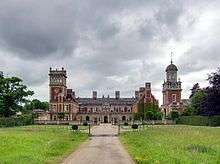Somerleyton Hall
Somerleyton Hall is a country house in the village of Somerleyton near Lowestoft, Suffolk, England. It is a Grade II* listed building[1] and has a notable garden.
History

In 1240 a manor house was built on the site of Somerleyton Hall by Sir Peter Fitzosbert, whose daughter married into the Jernegan family. The male line of the Fitzosberts ended, and the Jernegans held the estate until 1604.
In 1604 John Wentworth bought the estate. He transformed Somerleyton Hall into a typical East Anglian Tudor-Jacobean mansion. It then passed to the Garney family.
The next owner was Admiral Sir Thomas Allin, a native of Lowestoft. He took part in the Battle of Lowestoft (1665) and the Battle of Solebay at Southwold in 1672. Eventually the male line of that family also died out.
In 1843 Somerleyton Hall and Park were bought by the prosperous entrepreneur and MP Samuel Morton Peto. For the next seven years he carried out extensive rebuilding, creating an Anglo-Italian architecture masterpiece.[2] Paintings were specially commissioned for the house, and the gardens and grounds were completely redesigned. Peto employed Prince Albert's architect John Thomas; the clock tower houses a clock designed by Benjamin Vulliamy. Peto had garden features designed by William Andrews Nesfield and Joseph Paxton. Peto's son, Harold Peto, became a noted garden-designer, but it is not known whether he was influenced by the gardens of Somerlyton.
In 1863 the Somerleyton estate was sold to Sir Francis Crossley of Halifax, West Yorkshire who, like Peto, was a philanthropist, a carpet manufacturer, and a Member of Parliament. Sir Francis' son Savile was created Baron Somerleyton in 1916.
Present
The house is now held by Hugh Crossley, 4th Baron Somerleyton and inhabited by the family. The family motto is 'Everything that is good comes from above'.
The formal gardens cover 12 acres (4.9 ha) and for a part of a further 5000 acre Estate. They feature a yew hedge maze, one of the finest in Britain, created by William Andrews Nesfield in 1846, and a ridge and furrow greenhouse designed by Joseph Paxton, the architect of The Crystal Palace.[3] There is also a walled garden, an aviary, a loggia and a 90 metres (300 ft) long pergola covered with roses and wisteria. The more informal areas of the garden feature rhododendrons and azaleas and a fine collection of specimen trees.
In 1998 Lord and Lady Somerleyton commissioned the English painter of country houses, gardens and estates, Jonathan Myles-Lea to paint Somerleyton Hall. The house and grounds feature prominently in W. G. Sebald's novel The Rings of Saturn.
The house and grounds were used to stand in for Sandringham House in Stephen Poliakoff's 2003 television drama The Lost Prince.
The lake at Somerleyton Hall was used by Sir Christopher Cockerell, the inventor of the hovercraft, to carry out his early experiments.
Media
The Hall and its grounds featured as the principal location in "Neck", the sixth episode in the first series of Tales of the Unexpected (1976), and in episode 2 of the UK TV series, Interceptor.
Notes
- ↑ "Somerleyton Hall" at britishlistedbuildings.co.uk
- ↑ "Somerleyton Hall". BBC Suffolk. Retrieved 20 January 2013.
- ↑ "Gardens & maze" at somerleyton.co.uk
External links
| Wikimedia Commons has media related to Somerleyton Hall. |
- Map sources for Somerleyton Hall
- Official site
- Somerleyton Hall Garden
- Historic England. "Details from image database (282401)". Images of England.
Coordinates: 52°31′16″N 1°40′24″E / 52.52100°N 1.67336°E